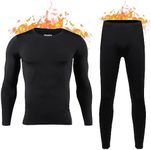Buying Guide for the Best Thermals
When it comes to buying thermals, it's important to choose the right product to keep you warm and comfortable in cold weather. Thermals are designed to provide insulation and retain body heat, making them essential for outdoor activities, winter sports, or simply staying warm during chilly days. To make an informed decision, you need to consider several key specifications that will help you find the best fit for your needs.MaterialThe material of thermals is crucial because it determines the level of warmth, comfort, and moisture-wicking ability. Common materials include wool, synthetic fibers, and cotton. Wool, especially merino wool, is excellent for warmth and moisture-wicking but can be more expensive. Synthetic fibers like polyester are good for moisture-wicking and are often more affordable, but they may not be as warm as wool. Cotton is comfortable but not ideal for moisture-wicking, making it less suitable for intense activities. Choose wool for maximum warmth and moisture control, synthetic for a balance of performance and cost, and cotton for casual, low-activity use.
WeightThermals come in different weights, which affect their warmth and bulkiness. Lightweight thermals are suitable for mild cold and high-activity levels, as they provide some warmth without causing overheating. Midweight thermals offer a balance of warmth and breathability, making them versatile for various activities and moderate cold. Heavyweight thermals provide maximum warmth and are best for extremely cold conditions or low-activity levels. Select lightweight for mild conditions or high activity, midweight for versatile use, and heavyweight for extreme cold or low activity.
FitThe fit of thermals is important for comfort and effectiveness. A snug fit ensures that the thermals can trap body heat and wick away moisture efficiently. However, they should not be too tight, as this can restrict movement and cause discomfort. Loose-fitting thermals may not provide adequate insulation. Look for a fit that is close to the body but allows for a full range of motion. Consider your activity level and personal comfort preferences when choosing the fit.
Layering CompatibilityThermals are often used as a base layer, so it's important to consider how they will work with other layers of clothing. They should be thin enough to fit comfortably under other garments without causing bulkiness. Additionally, they should have good moisture-wicking properties to keep you dry when layered. Think about the types of outer layers you will be wearing and ensure that your thermals can be easily layered without compromising comfort or mobility.
Moisture-WickingMoisture-wicking is the ability of the fabric to draw sweat away from your skin and allow it to evaporate. This is important for maintaining comfort and preventing chills, especially during physical activities. Wool and synthetic materials generally have good moisture-wicking properties, while cotton does not. If you plan to engage in activities that cause sweating, prioritize thermals with excellent moisture-wicking capabilities to stay dry and comfortable.
DurabilityDurability refers to how well the thermals can withstand wear and tear over time. High-quality materials and construction will ensure that your thermals last longer and maintain their performance. Look for reinforced seams, high-quality stitching, and materials known for their durability. If you plan to use your thermals frequently or for demanding activities, investing in durable options will provide better long-term value.
























